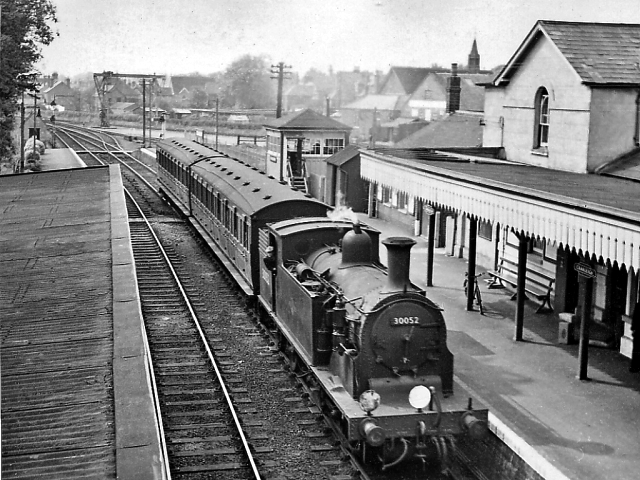Newport to Newhaven (3 days riding 100 miles over 5 days)
 I love cycling with my best mate, we have a great
laugh, I enjoy the company and it can make the trip more memorable, but there is a downside; he snores
like a banshee and he doesn’t maintain his bike (which drives me absolutely potty). In fact we only find
out about the faults on his bike when we’re riding.
I love cycling with my best mate, we have a great
laugh, I enjoy the company and it can make the trip more memorable, but there is a downside; he snores
like a banshee and he doesn’t maintain his bike (which drives me absolutely potty). In fact we only find
out about the faults on his bike when we’re riding.
There are also some conditions to the trips that he stipulates; hotels only, as flat as possible, stay away from main roads, less than 40 miles a day and a cup of tea every ten to twenty miles. The conditions take a lot of planning- less than forty miles is quite reasonable, in fact after wrong turns and private roads blocking progress, the predicted mileage is always over. We share rooms (with ear plugs) to keep the costs down, still, hotels in the UK are expensive, Youth hostels are the preferred accommodation but if there’s none on route it has to be Travelodge’s (even these are £60 plus now). Keeping the course flat is almost impossible but partially achievable using old railway lines and canals. The railway lines and canals (even though on Google they’re shown as cycle routes) can vary in their composition from tarmac to dirt tracks. So here it is Twickenham to Newhaven- three days of riding but spread over 5 days.
Day 1- Newport to Twickenham (Train)
I managed to get reservations for the bikes to Reading where we changed trains. The Newport to London route is very familiar with two possible attractions (for me that is); Swindon railway museum and Didcot Railway Centre. I’ve been to Didcot but not Swindon railway museum. We alighted at Reading and made our way to another platform (via a lift) and were shocked to see we had one minute on the station clock to board the Twickenham train. We hadn’t dawdled (no coffee or toilets) but only just piled onto the train before the doors shut. Either our incoming train was late or the train operators don’t leave enough time for people using lifts.
We arrived at Twickenham station on the Southern railway train. The train was overcrowded forcing us to stand next to a chap with strong body odour, it wasn’t pleasant and we were glad to get off. We asked our way to the Travelodge from a Gent outside the station, "it’s a few miles in that direction (pointing)". We crossed a bridge and had gone a total of 100 yards when it appeared on the left. We had planned to see a few of the stately homes in the afternoon but found out they shut at four o'clock. So a walk to the river, a few pints and food had to suffice. A well known pub on the river front was our first objective, but after seeing years of cobwebs in the roof space above the bar we decided to head to Wetherspoons for cheap beer and grub.
Day 2- Twickenham to Guildford (34 miles)
We were due to cross the river on a small ferry (just put in as my mate doesn’t like boats), but he wouldn’t take the bait. We continued riding along the Thames until we reached and crossed Richmond bridge then retraced our path. We passed Hampton court palace over the other side of the river and reached Sunbury weir, eventually reaching the Anglers pub at 10 miles for a well earned cup of coffee. The river homes (they don’t look like boats) must cost a fortune, theres loads of them dotted along the banks and this is obviously the place to row, as we counted at least ten rowing clubs along the river. We left the Thames and rode along a man made canal; the Desborough channel then along the Wey navigation to pretty a area; Coxes lock. After this there was a section of deep sand on the path, which I suggest was put there by a horse owner, I suggest this as there was horse shit everywhere, and near the end of the sand path was a nice road (that we could’ve ridden on instead of sand) this was fenced off and signed with a notice, which suggested if ridden on (or walked) the (private) road the owner will set the dogs on you.
We reached Bowers lock just as an argument was erupting on a canal boat between husband and
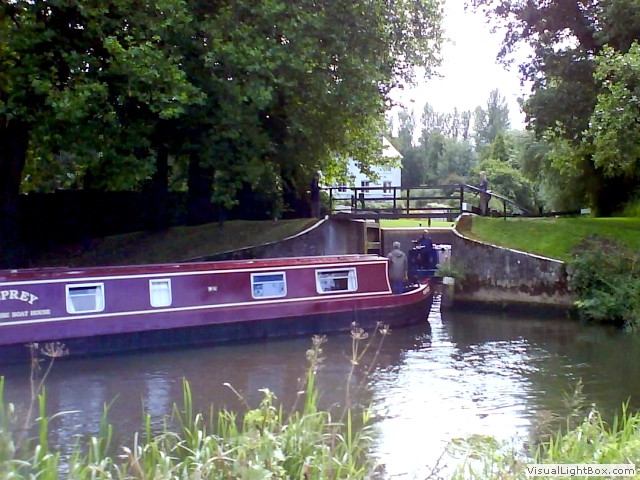 wife (presumably) about turning the boat into the lock. This entertained us for five to ten minutes
before we crossed the lock and continued on. The Garmin then turned us away from the river and across
a field and along a small lake which I later found out was Stoke meadows. Another right turn across
(Stoke nature reserve) wooden boards and back out onto the river Wey, then across to Stoke locks. We
turned off the canal onto a main road with two miles to go, on the left I noticed a mill (Stoke mill)
now occupied by the Surrey advertiser.
wife (presumably) about turning the boat into the lock. This entertained us for five to ten minutes
before we crossed the lock and continued on. The Garmin then turned us away from the river and across
a field and along a small lake which I later found out was Stoke meadows. Another right turn across
(Stoke nature reserve) wooden boards and back out onto the river Wey, then across to Stoke locks. We
turned off the canal onto a main road with two miles to go, on the left I noticed a mill (Stoke mill)
now occupied by the Surrey advertiser.
We arrived at the Guildford Travelodge after 35 miles. The new Travelodge’s have bars, we had a well deserved pint before changing and making our way towards Guildford town centre and straight towards Wetherspoons (again). To my surprise the Rodboro Building (Wetherspoons) used to be the home of the Dennis motor company (you know- busses and fire engines). It was steak night, so it was rude not to have a mixed grill (extra large).
Day 3- Guildford to Bramber (36 miles)
We decided just to have a Spanish omelette for breakfast and then off we’d go, or at least that’s what I planned. My mate’s front mudguard was really loose since Twickenham, but I didn’t have an 8mm spanner to tighten it. Now the darn thing was hanging off, luckily ‘Evans’ bike shop (other bike shops are available) was next to the Travelodge, a quick beg to the mechanics and at last we we were off.
 We passed some wooden and bronze sculptures along the river Wey, before running alongside a red brick
building and coming to Dapdune Wharf. Although no longer used commercially, the wharf is used for boat
trips. The Visitor Centre has interactive displays, a smithy, a stable, and two of the only three
remaining Wey barges in the world.
We passed some wooden and bronze sculptures along the river Wey, before running alongside a red brick
building and coming to Dapdune Wharf. Although no longer used commercially, the wharf is used for boat
trips. The Visitor Centre has interactive displays, a smithy, a stable, and two of the only three
remaining Wey barges in the world.
We crossed Milmead locks, through a small park and passed St Catharine’s lock. About two miles after Shalford Railway bridge we came across a pill box on the right. We stood near and discussed its potential to defend, if there were to be armed boats travelling along the river Wey it could take one maybe two out, after that the Germans would have attacked the pill box by land, no offense but it would be overrun in an hour. It would have only delayed progression at a great sacrifice.
We rode under a footbridge and the Garmin beeped at me telling me we’d gone the wrong way, we retraced our steps, crossed the river and realised we were now on the Downs link railway path. The path was straight and tree lined, in fact one could be riding along a tree lined avenue anywhere. The roots were growing into the path and there was barely a stretch without deep mud in the centre. The only way around was to go to the edge of the track and follow other cycle tracks, of course this way of riding forces your eye line down to the ground, so one can’t ride and look at the scenery. Occasionally a break in the trees allowed sight of the river, I believe if the weather had been inclement the path would have been un-ridable. We plodded on, but I can safely say the ride was barley enjoyable, I feel if this were one of the paths I did alone, it believe it would have been utterly miserable.
The tree avenue opened and a platform appeared; it was the Bramley and Wonersh station giving us
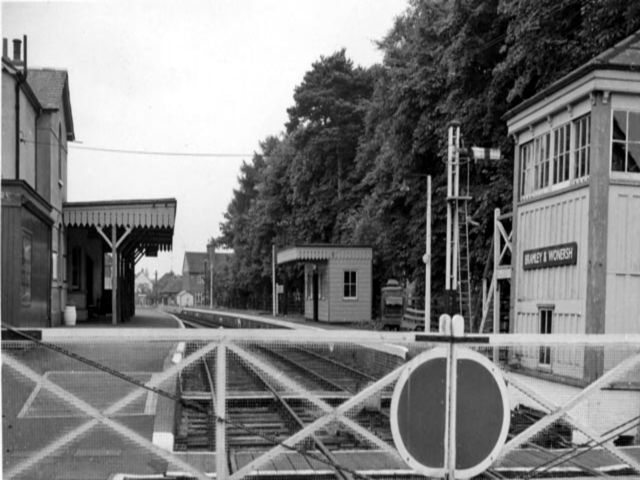 a brief restbite. There’s an interesting little story in the shelter about a train being bombed in
the war. On we went, back into the tree lined avenue, finally we had to cut across a road and decided to
have a coffee. To the left was Cranleigh, we sat in the sun and had a coffee in this pretty
village. It’s hard to believe the sun was so radiant (the cycle path tree canopy had diffused the
light). Back on the Downs link we came across people cutting the grass and generally tidying the
trail, and even though I moan about the path, it can easily be forgotten the pathway could be a lot worse
without these people.
a brief restbite. There’s an interesting little story in the shelter about a train being bombed in
the war. On we went, back into the tree lined avenue, finally we had to cut across a road and decided to
have a coffee. To the left was Cranleigh, we sat in the sun and had a coffee in this pretty
village. It’s hard to believe the sun was so radiant (the cycle path tree canopy had diffused the
light). Back on the Downs link we came across people cutting the grass and generally tidying the
trail, and even though I moan about the path, it can easily be forgotten the pathway could be a lot worse
without these people.
The path went adjacent to the rear of Asda where I believe Cranleigh station was and back into the tree canopy again, the next time we saw the light it was at Baynards Station. A fine looking station that looks as if it were expecting a train at any moment, but our view was blocked as it was a private residence. Out of respect the picture in the gallery showing the station is a stock photo as I respected the owner’s privacy. But not without my two penneth worth- I can see from old images the station has been restored by its current owners and I’m grateful to them for that, but it still doesn’t belong to them (yes, I know legally it does), it is part of our industrial heritage and belongs to all, the current owners are just custodians and the station will still be there long after they’ve gone.
After a moan to my mate we continued on, ahead the path became overgrown and impassable. A sign directed cyclists onto the road. Once on the road there were no signs for direction. The trusty Garmin suggested a route on the road a few miles out of the way and back into the village of Rudgwick to rejoin the path. It wasn’t until I returned home and surveyed the route I discovered the route was blocked by Baynards tunnel which was sealed (such a pity) to protect a colony of rare bats.
Down some dodgy steps and back on the route as directed. We passed an interesting bridge that was built on another bridge. Then later we dodged Slinfold caravan site only to be rudely directed off the path at Christ’s hospital school. A notice suggested we should stick to the signed path (and there was CCTV to make sure we did this) or risk being shot (the 'shot' bit I made up, but that’s what it felt like). At Christ’s hospital school the LB&SCR invested £30,000 (in the 1960's age of railway austerity) in the construction of a very substantial station building and adjacent goods yard, gambling on the school generating high levels of traffic and the possible expansion westwards of the growing town of Horsham, I'm not sure what's left as the station was hidden. The next remnants of a station was at Southwater, marked by a reproduction sign just before crossing a road.
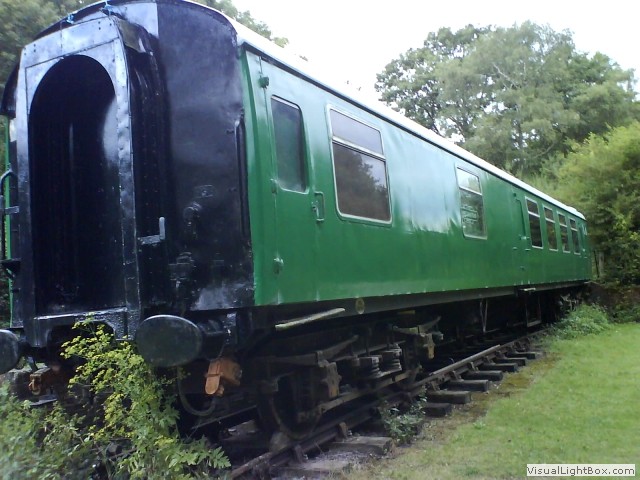 West Grinstead station opened up before us with an old carriage to the right. We climbed off the
bikes and investigated, two chaps were sat outside having some lunch (it transpired during a conversation
these were the curators of this mini museum). They allowed us to browse around, inside was a model railway
of West Grinstead, with its goods yards. On sale were a number of books and models and of course some light
refreshments if required. When we reached a double bridge the scenery opened up, at last we could see the countryside.
We came off the railway track at Partridge Green followed the road for a while then back on to the downs
link.
West Grinstead station opened up before us with an old carriage to the right. We climbed off the
bikes and investigated, two chaps were sat outside having some lunch (it transpired during a conversation
these were the curators of this mini museum). They allowed us to browse around, inside was a model railway
of West Grinstead, with its goods yards. On sale were a number of books and models and of course some light
refreshments if required. When we reached a double bridge the scenery opened up, at last we could see the countryside.
We came off the railway track at Partridge Green followed the road for a while then back on to the downs
link.
Eventually we ended up on farm tracks. Now I’m grateful to the farmer for allowing cyclists to ride across his land but it seemed like someone was taking the piss. This road (in the loosest terms) was driven across by wheels as big as me or by four wheeled Landrovers’ at the very least. Who in their right mind designated this as an appropriate cycle route? We were on 700c wheels; even mountain bike wheels would have taken a battering.
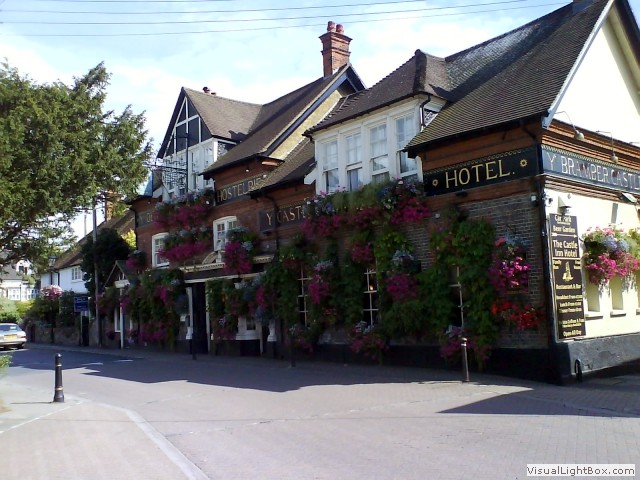 We turned into Bramber village and freewheeled until the Garmin said stop, we were there, 36 miles (should
have been 32 miles). We walked around the rear of this pretty pub and had a pint. I booked in and we were
shown where to lock the bikes. The floors leading to the room were slanting like the roof, that said the
room was nice and had full Sky TV, in my travels I’ve never had a room with full Sky TV; sports, movies,
discovery- it was all there. We had a cup of tea, showered and changed and headed (on the recommendation
of the West Grinstead chaps) to the Toll bridge hotel for a roast.
We turned into Bramber village and freewheeled until the Garmin said stop, we were there, 36 miles (should
have been 32 miles). We walked around the rear of this pretty pub and had a pint. I booked in and we were
shown where to lock the bikes. The floors leading to the room were slanting like the roof, that said the
room was nice and had full Sky TV, in my travels I’ve never had a room with full Sky TV; sports, movies,
discovery- it was all there. We had a cup of tea, showered and changed and headed (on the recommendation
of the West Grinstead chaps) to the Toll bridge hotel for a roast.
At the hotel reception the staff read out the options- £28 each for a three course meal (no chance), £21 each for a two course meal (still no chance), £14 each just for the main course (more like it but still pricey), or £6 each for a main course with a voucher (that’s it). “Do you have a voucher” she said as we looked at each other, we shook our heads, then she retrieved a voucher and handed it to us (we must have looked needy). Bargain. We had a pint and waited until the carvery was ready. At six it opened, not a traditional meat then help yourself to veg, it was dished out for you, all you had to do was pick what you wanted. My chum and I agreed this was the best carvery we had ever had, the beef was like fillet steak, the gammon was smoked, and succulent, the vegetables were as if they’d just been pulled from the garden, and the roasters were spot on.
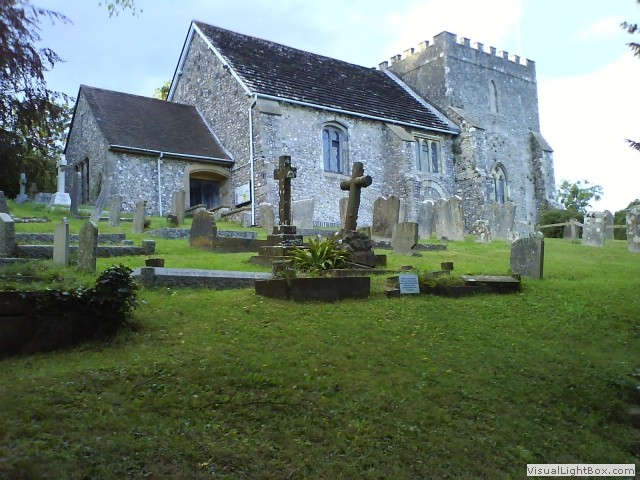 We left the restaurant with full belly's
and saw Bramber castle towering over the village. We decided to walk the dinner off and visited the church
and then the remains of this ancient castle. Once up there one could see why a castle was built on the
land, the views were spectacular. I walked around the grounds and bumped into a lad camping up there on
his own, he’d been on the road for two weeks stealth camping (camping anywhere bar campsites, something
I want to try). I wished him well and met back up with my mate. It wasn’t until I arrived home and did
some research for this blog I discovered the site was reputed to be haunted.
We left the restaurant with full belly's
and saw Bramber castle towering over the village. We decided to walk the dinner off and visited the church
and then the remains of this ancient castle. Once up there one could see why a castle was built on the
land, the views were spectacular. I walked around the grounds and bumped into a lad camping up there on
his own, he’d been on the road for two weeks stealth camping (camping anywhere bar campsites, something
I want to try). I wished him well and met back up with my mate. It wasn’t until I arrived home and did
some research for this blog I discovered the site was reputed to be haunted.
Day 4- Bramber to Newhaven (24 miles)
In the morning we had breakfast (at the Bramber castle hotel), that was also superb. I had eggs Benedict; I’ve never had it before, highly recommended. The old rail path followed the River Adur but like most old railways, it was pretty straight. We came across a wooden bridge crossing the river, it had a plaque giving the history and telling us this bridge used to be a main trunk road to Shoreham. Over the other side of the river was an airport which I later discovered was Brighton City airport. At this point my riding companions handle bar grips came loose, I had the tools to fix it this time. Though if I hadn’t the tools there was a 'Giant' bike shop just before the high street, maybe I ought to include cycle repair shops in the planning from now on.
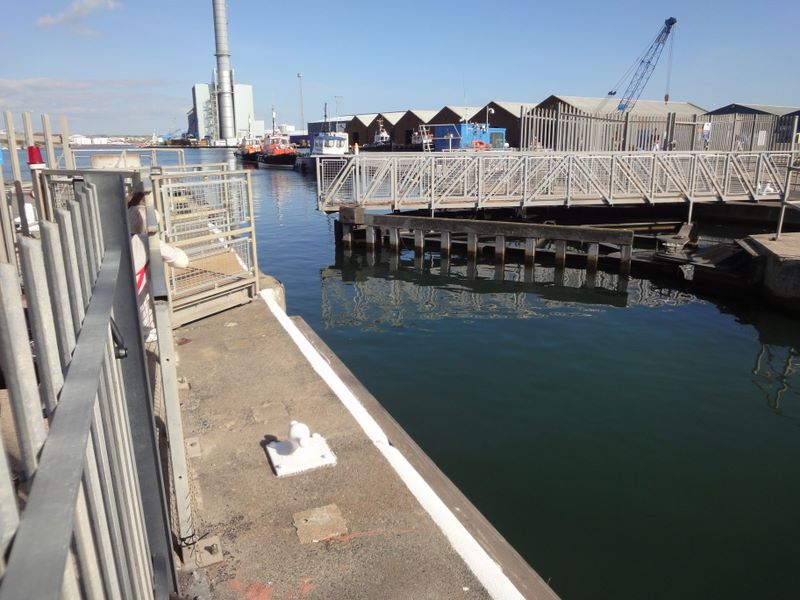 The route took us through the high street then left, right, left, right, left, right through a
housing estate, I suppose it kept us off the main 'A' roads. We crossed the road and down a little
alleyway to expose Shoreham harbour, we had to wait while massive lock gates shut, but I couldn’t see
a ship incoming or exiting. We crossed the locks and onto Basin road, the sea was roaring. As we rode
along the Kings esplanade the heavens opened, the rain bounced back 2 foot off the ground, we sheltered
in what looked like a double bus shelter for a few minutes but the rain didn’t abate. We decided to put
our wet weather gear on and continued. To be honest, it was quite pleasant; yes it was pouring down, but
it had an element I’ve never experienced with rain in the UK- It was warm. We rode along the esplanade
passing ‘no cycling’ signs everywhere, but what little people there were, were hurrying for shelter. We
stopped to take photos of the remains of the West Pier and noticed the Grand hotel behind us (scene of
the IRA bombing in 1984).
The route took us through the high street then left, right, left, right, left, right through a
housing estate, I suppose it kept us off the main 'A' roads. We crossed the road and down a little
alleyway to expose Shoreham harbour, we had to wait while massive lock gates shut, but I couldn’t see
a ship incoming or exiting. We crossed the locks and onto Basin road, the sea was roaring. As we rode
along the Kings esplanade the heavens opened, the rain bounced back 2 foot off the ground, we sheltered
in what looked like a double bus shelter for a few minutes but the rain didn’t abate. We decided to put
our wet weather gear on and continued. To be honest, it was quite pleasant; yes it was pouring down, but
it had an element I’ve never experienced with rain in the UK- It was warm. We rode along the esplanade
passing ‘no cycling’ signs everywhere, but what little people there were, were hurrying for shelter. We
stopped to take photos of the remains of the West Pier and noticed the Grand hotel behind us (scene of
the IRA bombing in 1984).
There were three things I wished to see in Brighton- The museum, the Volks railway and the main Pier. I was disappointed with the museum but at least we were out of the rain and we had a cup of tea. As we left we were distracted with an unusual building to the left; it was the Brighton Pavilion. Next onto the pier where we wasted a pound each on the ‘tipping point’ machines, two donuts later we were back on our bikes riding towards the Volks railway. The station was shut so we rode on, a few minutes later the Volks train passed us (it had just opened). We passed Black rock station and up the ramp, then down to the Marina. We wasn’t sure if the undercliff route was open as there was a gate across the path, then another cyclist came flying past the other way confirming it was open. It was a bit windy and the sea encroached onto the path, but it was a nice view. The path went as far as Saltdean where we had another cup of coffee in the Whitecliff’s cafe. We sneaked a peak of the now closed Saltdean lido and then on to Newhaven.
We turned off the main road onto a track (route 2), 'Hwy' lane is the worst national cycle route I’ve ridden on. It was barely ridable, then it got really bad. We turned down a footpath at the end of Hwy lane and greeted two French bikey tourists, to be honest I felt embarrassed that these people came over here to ride on a cycle path this bad. We were back on a road now and downhill to the Newhaven fort, something I wanted to see for a while, it didn’t disappoint. We rode to our digs and changed and went for a walk. I wouldn’t recommend our B&B or the food but I won’t degrade the trip by talking about them either.
Day 5- Newhaven to Newport (0 cycle miles)
We almost missed the Newhaven train, I thought it was 1120 but in fact it was 1105. The station had just celebrated its centenary in June with a steam train to Brighton. The station was decorated with old photos and believe it or not this little station still had a ticket booth open. We boarded the train along with quite a few other travellers, just as the doors were about to shut a group of French teens tried to get on, they held the doors open by standing in front of them for a good few minutes while their entourage jumped on.
It didn’t take long before we were at Lewes station. One of the platforms had been filled in for some reason, by the time we crossed a elevated ramp to the other platform our train was pulling into the platform (courtesy of the French teens our train was late). Just by pure luck we boarded the train at the right place, but two wheel chairs took the space, so we stood. I have heard stories of overzealous conductors throwing cyclists off train for blocking the aisles. My fears were unfounded as the conductor was a nice chap. The disabled people alighted at Clapham junction (scene of the Uk’s worst rail disaster) one stop before the termination of our journey. Just as we were slowing for London Victoria I noticed the iconic Battersea power station out of the right window.
We didn’t have much time to cross London on the tube to catch our train in Paddington. The journey on the tube was uneventful easily popping us up beneath Paddington with 15 minutes to spare. We looked at the electronic matrix board, our train was waiting on platform 3. Researching travelling without a cycle reservation I came across a blog saying they’ve had problems getting on the train at Paddington without cycle reservations. It stated they wouldn’t let them through the barrier without one. We flew through the gates unrestricted, but maybe due to the needless stress, unbeknown to us, we got on the wrong train. We checked the seat reservation tickets- yep it was going to Cardiff. It wasn’t until the time of our departure came and went, we realised something was wrong. Too late now, it was just luck we were on a later train going to the same place. The ticket collector was very understanding as we stated we carried our bikes across the underground network, we arrived home 30 minutes after our scheduled time.
Did we enjoy the whole ride? Yes. Would I have enjoyed the ride on my own? No. Travelling along railway trails and canal paths is not without compromise, at some stages we were averaging less than 5 mph or even walking pace. If you’re not a train buff (and I am) the ride would be totally boring.
-
Gallery
 Why not have a look at the gallery relating to this ride. Click the image or the title.
Why not have a look at the gallery relating to this ride. Click the image or the title. -
Steam
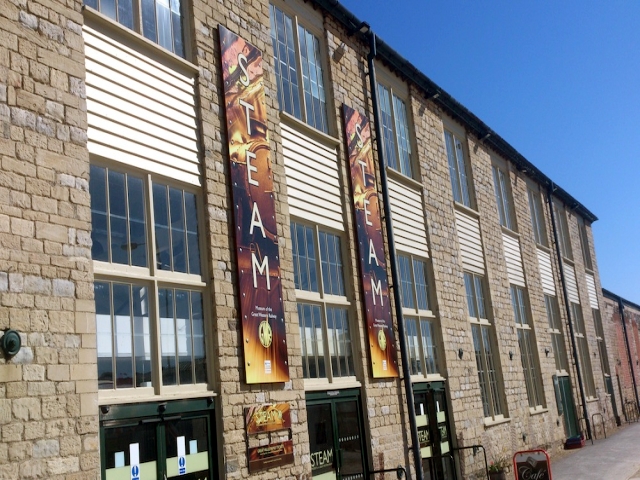 Museum of the Great Western Railway, also known as Swindon Steam Railway Museum, is located at the
site of the old railway works in Swindon, England– Wiltshire's 'railway town'. The museum opened in
2000 and replaced the former GWR Museum, which was located on Faringdon Road in Swindon.
Museum of the Great Western Railway, also known as Swindon Steam Railway Museum, is located at the
site of the old railway works in Swindon, England– Wiltshire's 'railway town'. The museum opened in
2000 and replaced the former GWR Museum, which was located on Faringdon Road in Swindon. -
Twickenham
Twickenham's demonym is 'the home of English rugby': the headquarters of the Rugby Football Union is at Twickenham, as is Twickenham Rugby Stadium, the world’s largest stadium officially solely for rugby, which also hosts seasonal and particularly charity music concerts.
-
The River Thames
The River Thames flows through southern England. It is the longest river entirely in England and the second longest in the United Kingdom. While it is best known for flowing through London, the river also flows alongside other towns and cities, including Twickenham, Oxford, Reading, Henley-on-Thames and Windsor.
-
Dennis Specialist Vehicles Ltd.
Dennis Specialist Vehicles Limited was a major British coachbuilder and manufacturer of specialised commercial vehicles based in Guildford, England. The company was best known as the manufacturer of fire engines, although its other major product lines were buses, dustcarts and airport service vehicles.
-
Guildford
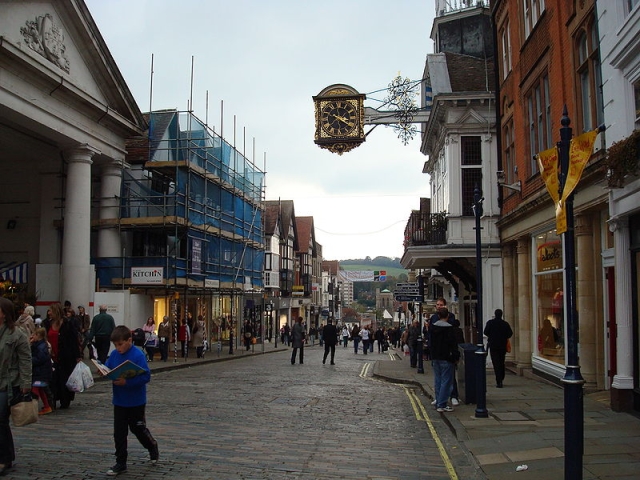 Guildford is the county town of Surrey, England. It has Saxon roots and historians attribute its
location to the existence of a gap in the North Downs where the River Wey was forded by the Harrow
Way. The town's access was sufficient that by AD 978 it was home to an early English Royal Mint.
Guildford is the county town of Surrey, England. It has Saxon roots and historians attribute its
location to the existence of a gap in the North Downs where the River Wey was forded by the Harrow
Way. The town's access was sufficient that by AD 978 it was home to an early English Royal Mint.
-
Alices Adventures in Wonderland
The story of Alice’s adventures in Wonderland was first written in 1865 by Lewis Carroll, it tells a tale of a young girl growing up, facing change and difficulties, Alice chases the fretful white rabbit who’s clutching an oversized pocket watch and falls into a delusional realm of conceptual characters.
-
Pillboxes
Pillboxes are concrete dug-in guard posts, normally equipped with loopholes through which to fire weapons. The originally jocular name arose from their perceived similarity to the cylindrical and hexagonal boxes in which medical pills were once sold. They are in effect a trench firing step hardened to protect against small-arms fire and grenades and raised to improve the field of fire.
-
Bramley and Wonersh station attack
In WW2 a German Dornier 217 aircraft attacked a train carrying Christmas shoppers as it was departing Bramley and Wonersh on 16 December 1942. The plane machine-gunned the train and dropped a bomb that exploded on the embankment, narrowly missing the train. The driver and guard were killed, a number of passengers were killed or wounded and the train was badly damaged. The fireman and the porter-in-charge of Bramley station attended the wounded and dying, later helped by six soldiers who were billeted nearby.
-
Cranleigh station
. -
Private heritage buildings
'Historic community buildings, neighborhoods, and landscapes embody the intentions, assumptions, and lives of those who built or lived or worked in them. They have stories to tell about what the community was and how it became what it is, and that helps us understand who we are. Preserving those stories can be an important part of building a healthy community' (Ctb.ku.edu).
Here, here. But .............
'Article 8 of the European Convention on Human Rights provides that:
Everyone has the right to respect for his private and family life, his home and his correspondence'. (Anon) -
Are farm tracks suitable cycle paths?
 Who’s idea was this? I can appreciate when this was first inspected it may have looked different, but
now it’s near to ‘get off and walk’.
Who’s idea was this? I can appreciate when this was first inspected it may have looked different, but
now it’s near to ‘get off and walk’. -
Bramber
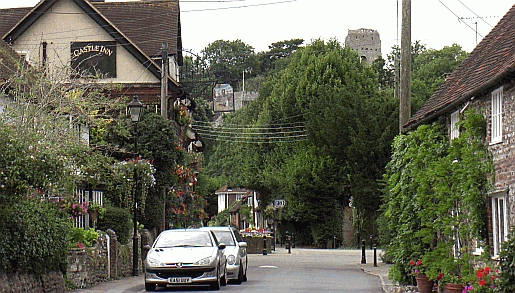 Bramber is only a small village on the River Adur north of Shoreham, but it used to be a place of strategic
importance. An old roman road descends west-south-west through Woodmancote and across Small Dole to the
north of Bramber and crosses another which cuts a south east route from Storrington and through Wiston
Park. Usually such crossings were combined with way-castles, like glorified camps, but at
Bramber there was rumour of something more substantial- possibly the Roman fleet.
Bramber is only a small village on the River Adur north of Shoreham, but it used to be a place of strategic
importance. An old roman road descends west-south-west through Woodmancote and across Small Dole to the
north of Bramber and crosses another which cuts a south east route from Storrington and through Wiston
Park. Usually such crossings were combined with way-castles, like glorified camps, but at
Bramber there was rumour of something more substantial- possibly the Roman fleet.
Given the later Norman Castle and the village’s strategic position on the river it's position would seem ideal for a more substantial bastion, but the bustling port, like Steyning, changed it's status as the river silted up and Bramber found itself in the wrong place at the wrong time. -
The Old Tollgate Hotel & Restaurant
The Old Tollgate Hotel & Restaurant, built on the site of the original Toll Gate which governed access to The Street. Although a modern building, part of it still dates from 1701. It has won several awards during 2011 including a Green Tourism Gold.
-
Photographic evidence of Bramber castle ghosts
 During the reign of King John, the castle was owned by William de Braose. He and the King
hated each other and King John eventually ordered troops to storm the castle, but the Baron heard of the plan
and fled the country.
During the reign of King John, the castle was owned by William de Braose. He and the King
hated each other and King John eventually ordered troops to storm the castle, but the Baron heard of the plan
and fled the country.
King John sought revenge and took the Baron's children as hostages. He imprisoned them in a tower at Windsor Castle and left them there to die of starvation.
The ghosts of these children have been seen pathetically begging for bread near their old home of Bramber, dressed in ragged clothes and holding out their hands for food. -
Residents of Brighton and Hove vote against cyclists
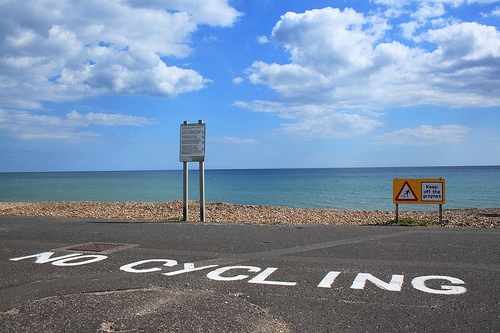 'Residents want Brighton and Hoves' promenade kept bike free, reveals a survey by local Conservatives. The
Council’s plan of lifting the current ban on cycling on the iconic seafront route, between the Peace
status and Hove lagoon, was objected to by a clear two-thirds majority of residents.' (Brighton & Hove
Conservatives, 2013)
'Residents want Brighton and Hoves' promenade kept bike free, reveals a survey by local Conservatives. The
Council’s plan of lifting the current ban on cycling on the iconic seafront route, between the Peace
status and Hove lagoon, was objected to by a clear two-thirds majority of residents.' (Brighton & Hove
Conservatives, 2013)
My view- The esplanade was fifty feet wide and we were riding at mid day (peak time), there was barely enough people along the front to make a football team. I think the residents are being a tad selfish. -
Newhaven fort
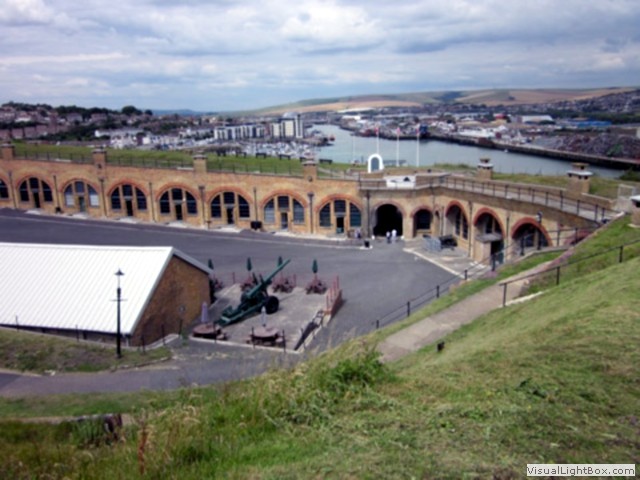 During the 1860s a French invasion was feared, a fortress was commissioned to protect the harbour entrance.
The Fort is ideally situated on the cliff overlooking the harbour and commanding the approaches to it.
Underground passages lead to a lunette battery and to casemates protecting the moats. It was used in both
world wars.
During the 1860s a French invasion was feared, a fortress was commissioned to protect the harbour entrance.
The Fort is ideally situated on the cliff overlooking the harbour and commanding the approaches to it.
Underground passages lead to a lunette battery and to casemates protecting the moats. It was used in both
world wars. -
Battersea Power Station
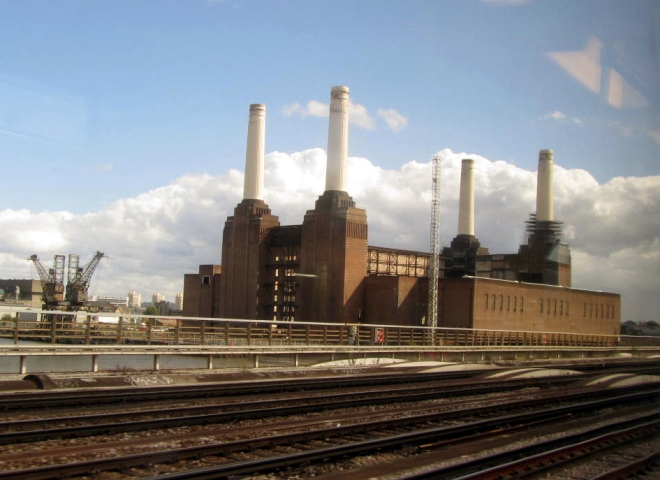 The station ceased generating electricity in 1983, but over the past 50 years it has become one of
the best known landmarks in London and is Grade II listed. The station's celebrity owes much to
numerous cultural appearances by famous bands. Since the station's closure the site has remained
largely unused, with numerous failed redevelopment plans from successive site owners.
The station ceased generating electricity in 1983, but over the past 50 years it has become one of
the best known landmarks in London and is Grade II listed. The station's celebrity owes much to
numerous cultural appearances by famous bands. Since the station's closure the site has remained
largely unused, with numerous failed redevelopment plans from successive site owners. -
Bibliography
Ctb.ku.edu, (2014). Chapter 26. Changing the Physical and Social Environment- Section 7. Encouraging Historic Preservation- Main Section. [online] Available at: http://ctb.ku.edu/en/table-of-contents/implement/phsyical-social-environment/historic-preservation/main [Accessed 21 Aug. 2014].
Anon,(2014).
Brighton & Hove Conservatives, (2013). No Cycling On Promenade. [online] Available at: http://www.brightonand hoveconservatives.co.uk/2013/10/no-cycling-on-promenade/ [Accessed 23 Aug. 2014].

 Museum of the Great Western Railway, also known as Swindon Steam Railway Museum, is located at the
site of the old railway works in Swindon, England– Wiltshire's 'railway town'. The museum opened in
2000 and replaced the former GWR Museum, which was located on Faringdon Road in Swindon.
Museum of the Great Western Railway, also known as Swindon Steam Railway Museum, is located at the
site of the old railway works in Swindon, England– Wiltshire's 'railway town'. The museum opened in
2000 and replaced the former GWR Museum, which was located on Faringdon Road in Swindon.
